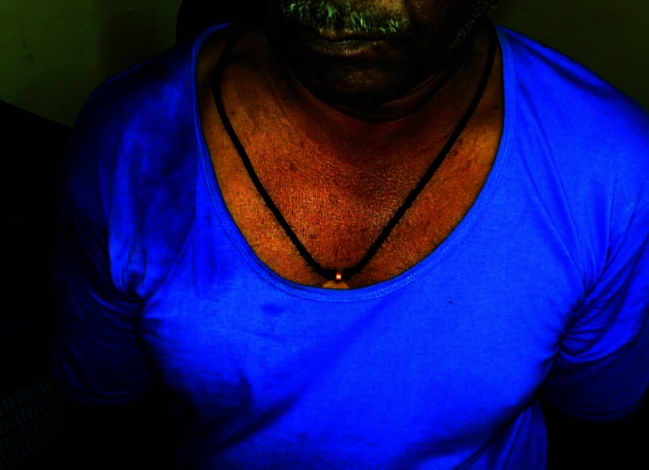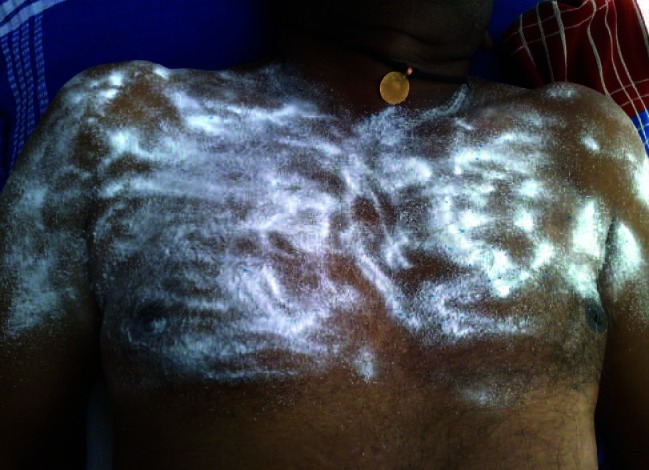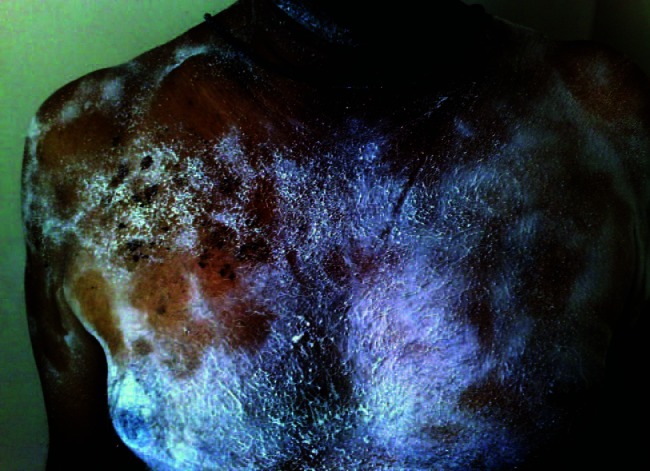Sir,
Sweating is an important mechanism in the regulation of a constant body temperature. Hyperhidrosis is defined as an excess of sweating beyond the amount required to return elevated body temperature to normal, with a distinction between primary and secondary forms of hyperhidrosis. The primary or essential form arises mainly from emotional factors and is located in most cases in the axilla, on the palms of the hands, or on the soles of the feet. In the secondary form, an underlying neurologic or endocrinological disease is the cause of the usually diffuse sweating. Besides these quite common forms of hyperhidrosis, rare disorders such as Frey syndrome or Ross syndrome, which also have an underlying neurologic cause, can produce localized hyperhidrosis.[1]
A few cases of localized unilateral or segmental hyperhidrosis (LUH)[2–7] are described in the literature that do not fit into the mentioned categories. The involved area in unilateral circumscribed hyperhidrosis is usually sharply demarcated and no larger than 10 × 10 cm1. It occurs mainly on the face and upper extremities of otherwise healthy individuals. Profuse sweating, which is usually precipitated by heat, lasts 15 to 60 minutes. Localized unilateral hyperhidrosis has none of the typical triggering factors found with essential hyperhidrosis. The attacks occur with no apparent cause, even during the night while the patients are asleep. The pathogenesis of LUH remains unclear. Some authors have related the disease to neurologic disturbances or malignant disease. Herein, we describe a patient with LUH in whom the cause may be a past trauma in the affected area.
An elderly male aged 62 years presented in our out-patient department with history of increased sweating over right side of chest, since two months. [Figure 1] Patient was diabetic and was on regular treatment. He had history of trauma of falling from a height, 20 years ago. Family and personal history were otherwise uneventful. The patient could not identify any triggers for the hyperhidrosis that occurred in isolated attacks. He also gives history of increased sweating in the affected area lasting for 20-30 minutes with no abnormality of sweating in the other areas during the attack. A dependence on emotions, environmental temperature, or physical efforts was denied. There was no history of herpes zoster in the affected site. On local examination there were no hypopigmented anaesthetic patches ruling out Hansen's. Systemic examination was unremarkable. Results of laboratory tests, including endocrinological examination, and neurologic tests, including electromyography, were normal. Chest X-ray showed no bony abnormalities or any mass. Ophthalmologic examination showed no irregularity in pupil and normal light reflex. Results of a biopsy taken from affected site showed no increase of sweat glands compared to a biopsy taken from opposite side, thus excluding an eccrine nevoid lesion. Normal results of the iodine starch test (Minor sweat test) were found during symptom-free intervals [Figure 2]. The patient underwent the test and was able to document a sharply demarcated area of focal hyperhidrosis 8 × 6 cm in diameter on the right side of chest during attacks [Figure 3]. Topical treatment with aluminium chloride[8,9] produced an satisfactory response after three months of follow-up. Also the patient was advised Iontophoresis and Botulinum toxin injections, but was not performed due to logistical problems.
Figure 1.

Increased sweating localized to right side of the chest
Figure 2.

Normal results of iodine starch test (Minor sweat test) during symptom-free intervals
Figure 3.

Idiopathic circumscribed hyperhidrosis over right side of chest of 8 × 6 cm in diameter during an attack (indicated by Iodine-starch test which turned black on hydration). The rest of the patients sweating and neurological examination was normal
This case is being reported due to its rarity of presentation and paucity of reports in literature and the need for high index of suspicion with an unbiased examination of the patient.
References
- 1.Sato K, Kang WH, Saga K, Sato KT. Biology of sweat glands and their disorders, II: disorders of sweat gland function. J Am Acad Dermatol. 1989;20:713–26. doi: 10.1016/s0190-9622(89)70081-5. [DOI] [PubMed] [Google Scholar]
- 2.Boyvat A, Piskin G, Erdi H. Idiopathic unilateral localized hyperhidrosis. Acta Derm Venereol. 1999;79:404–5. doi: 10.1080/000155599750010508. [DOI] [PubMed] [Google Scholar]
- 3.Cunliffe WJ, Johnson CE, Williamson DM. Localized unilateral hyperhidrosis: A clinical and laboratory study. Br J Dermatol. 1972;86:374–8. doi: 10.1111/j.1365-2133.1972.tb05050.x. [DOI] [PubMed] [Google Scholar]
- 4.Köse O, Baloglu H. Idiopathic unilateral circumscribed hyperhidrosis. Int J Dermatol. 1997;36:209–10. doi: 10.1111/j.1365-4362.1997.tb04184.x. [DOI] [PubMed] [Google Scholar]
- 5.Rufli T, Itin P, Gilli L. Localized unilateral hyperhidrosis. Dermatol. 1992;184:298–9. doi: 10.1159/000247576. [DOI] [PubMed] [Google Scholar]
- 6.Takase Y, Tsushimi K, Yamamoto K, Fukusako T, Morimatsu M. Unilateral localized hyperhidrosis responding to treatment with clonazepam [letter] Br J Dermatol. 1992;126:416. doi: 10.1111/j.1365-2133.1992.tb00695.x. [DOI] [PubMed] [Google Scholar]
- 7.Sato KT, Richardson A, Timm DE, Sato K. One-step iodine starch method for direct visualization of sweating. Am J Med Sci. 1988;295:528–31. doi: 10.1097/00000441-198806000-00006. [DOI] [PubMed] [Google Scholar]
- 8.Eisenach JH, Atkinson JL, Fealey RD. Hyperhidrosis: Evolving therapies for a well-established phenomenon. Mayo Clin Proc. 2005;80:657–66. doi: 10.4065/80.5.657. [DOI] [PubMed] [Google Scholar]
- 9.Duthie AM, Dunkley AS. Aluminium chloride for hyperhidrosis. Drug Ther Bull. 1981;117:617–26. [PubMed] [Google Scholar]


